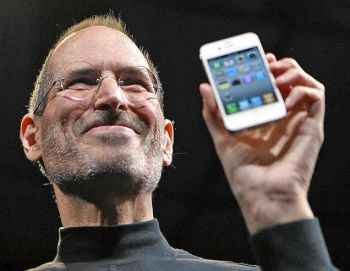Elevate: Launching and Leading A Social Media Practice
On June 7, 2010 the late Steve Jobs took the stage at the World Wide Developers Conference in San Francisco to announce Apple's latest break through release, the iPhone 4. The tag line read "This changes everything. Again."He wasn't lying. I was 6 months into my newly minted role managing social media for RadioShack, their first foray into the space. This announcement signaled the end of my honeymoon phase and represented the first time in RadioShack's 90-year history that the iconic retailer would be a launch-day destination for Apple devices. Previously they only received Cupertino's finest imports after the national release and after the competition.That day we sardined into a conference room, throwing out options and brainstorms for how on earth we could tell the masses we would be slanging Apples. The launch was in 17 days, which meant we had 7 days to convince customers we were actually selling the device and 7 hours to say it first. Every eye in the room was like a spotlight facing my direction. Enter social media.
I was 6 months into my newly minted role managing social media for RadioShack, their first foray into the space. This announcement signaled the end of my honeymoon phase and represented the first time in RadioShack's 90-year history that the iconic retailer would be a launch-day destination for Apple devices. Previously they only received Cupertino's finest imports after the national release and after the competition.That day we sardined into a conference room, throwing out options and brainstorms for how on earth we could tell the masses we would be slanging Apples. The launch was in 17 days, which meant we had 7 days to convince customers we were actually selling the device and 7 hours to say it first. Every eye in the room was like a spotlight facing my direction. Enter social media.
Social Media Takes Center Stage
Seemingly overnight, social media at RadioShack accelerated from being a nascent, emerging tool for niche conversations to an urgent channel for driving the business. What was previously a thermometer - reacting to consumer and business stimuli - became a thermostat, setting the pace for how our brand comes to life across 35,000 associates in 27 countries and 6,000 stores.It was the end of my honeymoon and the beginning of an inevitable journey. The business no longer needed someone to manage social. They needed someone to lead it. My approach was no longer sufficient. They needed a visionary and a coach more than a community manager. The business required internal alignment and strategy, not just advocacy. It was time for me and social media to grow up.I'm convinced any conversation about social business has one undeniable punchline: social leadership. When done right, social media marketing evolves into a business practice that builds internal and external relationships across the organization. It was never intended to be a solo show. For me, this conversion from circus act to ring leader involved 7 points of individual and organizational elevation.
Social leaders must elevate...
1. From Community Manager to Coach
 Community is the currency of social media. Managing those relationships is vital, but it's also teachable and transferable. Recruit the right talent and give them permission to fail. I know, it's one of the hardest things to do but also the most critical. Don't expect them to say and do things exactly how you would. Instead, a good coach builds a playbook that agencies, interns and co-workers can follow. Create a social media practice that works without you, not because of you.
Community is the currency of social media. Managing those relationships is vital, but it's also teachable and transferable. Recruit the right talent and give them permission to fail. I know, it's one of the hardest things to do but also the most critical. Don't expect them to say and do things exactly how you would. Instead, a good coach builds a playbook that agencies, interns and co-workers can follow. Create a social media practice that works without you, not because of you.
2. From Evangelist to Educator
My focus is no longer on spreading the gospel of social media. Ironically, the ever-growing ocean of stats, facts and figures regarding social usage are useless until you educate your business on how to be social. This requires an elevation in your approach. Speak to people about data, specific use-cases, financial impact and consumer response. Most CMOs already know the cost of social so it's a leader's job to show the value.
3. From External Advocacy to Internal Alignment
Without an audience there is no brand. Without alignment there is no business. Outreach to influencers and brand ambassadors requires dedicated efforts across the organization. As a social chief, it becomes my job to balance this external focus with my internal function as a liaison, ensuring we deliver on the conversations our advocates are having. It's perfectly OK to have multiple leaders own a piece of social strategy. In fact, it's a sign of organizational maturity. Just remember: leadership is plural, vision is singular. Elevate and be the visionary.
4. From Test & Learn to Prove & Do
Innovation is important but it's not everything (I can't believe I just typed that). Once you test a platform and evaluate its merits, it's time to take action. I had to elevate my conversations from mere recaps of engagement metrics (likes, fans, followers, retweets, etc.) to performance measures that are relevant to the business. Contrary to popular opinion, there is a ROI component to social media and it's the leader's responsibility to represent this internally. Here are the 4 measures I have found most valuable:
1. Competitive Share of Voice - How much of the online conversation did we impact/influence versus our competitive set? Measured via Radian6, Alterian or whatever your listening tool of choice is.
2. Media Efficiency - How much money did we save by using social channels and tactics versus conventional media? Measured by calculating a CPM for the total audience and comparing directly to paid media rates (or industry benchmarks if you're in PR).
3. Revenue Attribution - How many sales transactions resulted from this campaign? Measured by injecting a direct response component (unique code, digital tracking, etc.) into the social experience that connects potential customers to actual transactions.
4. Online Profit - How much profit (return on ad spend) did this interactive campaign drive. If your business has an e-commerce function this is simply measured using the same approach as other digital drivers.
5. From Brand Program to Business Practice
As it matures, social becomes much bigger than a marketing channel. Leading a practice requires oversight of enterprise-wide needs that fall well beyond the job description of a community manager or individual contributor. This includes budgeting for operational support and social advertising, constantly reviewing agency rosters to assess scope and competency, evolving and championing staffing plans and procuring proven talent for specialized needs. This point of elevation required me to take off the rock star hat and build a stage where everyone can have rock star results.
6. From Mobile as 3rd Screen to 1st Screen
I'll admit it. Smartphone penetration in the U.S. is increasing faster than the I.Q. of most marketers. What was once an extension of our traditional campaigns has become the center of our consumer interactions. Forty percent of social users are accessing the channels via mobile devices and some, my wife included, have no clue what the desktop version of Facebook even looks like. I suppose we can thank Mr. Jobs for that as well.
7. From Policies to Protection
 This one isn't much fun. When I wrote the social media policy for The Shack, it was intended to instill guiding principles and philosophies for navigating the online space. It was an internal document with an intentional focus - protect our brand from itself. The most urgent need now is protection from others. The business of social media is the business of trust. Without it, disaster ensues. That trust must be protected by guarding privacy, securing intellectual property, scrutinizing licensing agreements and even counteracting legal claims. Technology has created immense opportunity, especially for lawyers. Leaders keep their enemies close and their lawyer on speed-dial.
This one isn't much fun. When I wrote the social media policy for The Shack, it was intended to instill guiding principles and philosophies for navigating the online space. It was an internal document with an intentional focus - protect our brand from itself. The most urgent need now is protection from others. The business of social media is the business of trust. Without it, disaster ensues. That trust must be protected by guarding privacy, securing intellectual property, scrutinizing licensing agreements and even counteracting legal claims. Technology has created immense opportunity, especially for lawyers. Leaders keep their enemies close and their lawyer on speed-dial.
What's Next?
Managing communities, growing advocates, testing technology and crafting creative marketing programs are the core of social media and abundantly necessary. A social leader must be able to manage these critical components while also looking at the bigger, sometimes blurry, picture. These are the guiding principles I will take with me in my new position leading social, mobile and emerging media at Intuit. I start next Monday.I'm looking forward to presenting them today at the Social Fresh conference in Tampa. As a follow-up, I'm committing to post links and more detailed examples of the tools I used to elevate. If you find them helpful let me know your thoughts and if you totally disagree, let me know why.UPDATE: Follow the tag #ElevateSocial for more updates, including my SlideShare presentation and a follow-up blog post, Staying Social Fresh.APTwitter – @adriandparkerLinkedIn – www.linkedin.com/in/adriandparker

